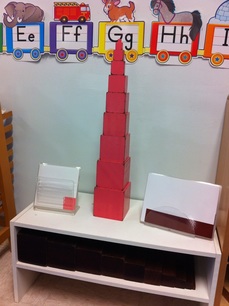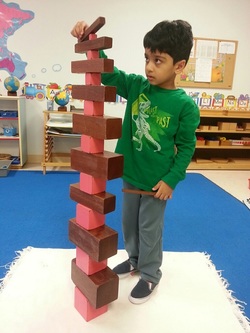
Montessori believed that nothing comes into the mind except through the senses. During the years between three and six, as children develop their senses, their attention is directed toward the environment. The purpose of the Sensorial activities is to help the child in his efforts to sort out the many varied impressions given by the senses. These materials are specifically designed to help the child develop discrimination, order, and to broaden and refine the senses. These materials also help prepare him to be a logical, aware, and perceptive person. Like many other materials in the Montessori classroom, sensorial materials have what is called "control of error", meaning that the child not only works with the material, but has a way to check their work rather than seeking out the teacher if they have a question on whether or not they did it right. This is done to help promote independence and problem solving on the part of the child. Visual discrimination of difference in dimension, width, length, and size can be found in materials such as the Pink Tower, Brown Stair, Red Rods, and Knobbed Cylinders. Other activities that enhance visual sense are the Color Tablets, Geometric Cabinet, and the Constructive Triangles.
The Touch-Tablets, and Fabric-Feel isolate the tactile sense, while Sound Cylinders and Bells train the auditory sense. The Mystery Bag helps to develop the stereognostic sense (the tactile-muscular sense).
After experiencing Sensorial activities, the child's sense perceptions will appear inherently structured and capable of comprehending abstract concepts. The Pink Tower, Brown Stair, and Red Rods are a sequence of materials designed to enable a young child to explore dimension. The Pink Tower is the shining gem in the sensorial area of the Montessori classroom. The ten bright pink wooden cubes are designed to entice the child to enter into the world of dimension. The sizes of the cubes range from the smallest cube of 1cm cubed and the largest at the bottom 10cm cubed. The cubes increase progressively in the algebraic series of the third power. So, the second cube equals 8 of the first while the third cube equals 27 of the first and so on.
The work is designed to provide the child with a concept of "big" and "small."
The child starts with the largest cube and puts the second-largest cube on top of it. This continues until all ten cubes are stacked on top of each other. The control of error is visual. The child sees that the cubes are in the wrong order and knows that he/she should fix them. The successive dimensions of each cube are such that if the cubes are stacked flush with a corner, the smallest cube may be fit squarely on the ledge of each level.
The Touch-Tablets, and Fabric-Feel isolate the tactile sense, while Sound Cylinders and Bells train the auditory sense. The Mystery Bag helps to develop the stereognostic sense (the tactile-muscular sense).
After experiencing Sensorial activities, the child's sense perceptions will appear inherently structured and capable of comprehending abstract concepts. The Pink Tower, Brown Stair, and Red Rods are a sequence of materials designed to enable a young child to explore dimension. The Pink Tower is the shining gem in the sensorial area of the Montessori classroom. The ten bright pink wooden cubes are designed to entice the child to enter into the world of dimension. The sizes of the cubes range from the smallest cube of 1cm cubed and the largest at the bottom 10cm cubed. The cubes increase progressively in the algebraic series of the third power. So, the second cube equals 8 of the first while the third cube equals 27 of the first and so on.
The work is designed to provide the child with a concept of "big" and "small."
The child starts with the largest cube and puts the second-largest cube on top of it. This continues until all ten cubes are stacked on top of each other. The control of error is visual. The child sees that the cubes are in the wrong order and knows that he/she should fix them. The successive dimensions of each cube are such that if the cubes are stacked flush with a corner, the smallest cube may be fit squarely on the ledge of each level.

My favorite part of this work is watching a child stand back in complete amazement when it is completed the correct way. Each piece is carried individually to a rug which builds character and patience. The extensions are endless. The diameter of the Pink Tower is the same as the Brown Stair so the child can combine both works once they have mastered each one. A child in my class once built it like the leaning Tower of Pisa. To my astonishment the angle was perfect so it only leaned and did not fall over! I have had children trace each piece on pink paper and cut each one out to build their pink tower to take home. The sensorial area helps build directly and indirectly the mathematical mind. I wonder how many mathematicians or architects will blossom from this work.

 RSS Feed
RSS Feed